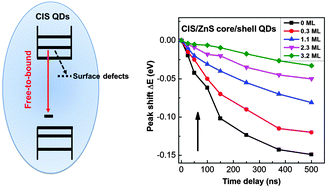Photocarrier recombination dynamics in ternary chalcogenide CuInS2 quantum dots
Abstract
Photocarrier recombination dynamics in ternary chalcogenide CuInS2 quantum dots (CIS QDs) was studied by means of femtosecond transient-absorption (TA) and nanosecond time-resolved photoluminescence (PL) spectroscopy. Under strong excitation, the TA dynamics in CIS QDs is well described by a simple rate equation including single-carrier trapping, free-to-bound recombination, and trap-assisted Auger recombination. Under weak excitation, on the other hand, the PL decays of the QDs are composed of a short-lived component caused by surface trapping and a long-lived one caused by free-to-bound recombination. It is found that the surface trapping accelerates markedly with decreasing QD size while the free-to-bound radiative recombination hardly depends on the QD size. Besides this, we observed both a decrease in the PL lifetimes and a dynamic spectral redshift, which are attributed to the surface trapping and the coexistent inhomogeneous broadening in CIS QDs. The spectral redshift becomes less pronounced in CIS/ZnS core/shell QDs because of the suppression of the fast nonradiative recombination caused by the passivation of the surface traps. These results give clear evidence that the free-to-bound model is appropriate for interpreting the optical properties of CIS QDs.


 Please wait while we load your content...
Please wait while we load your content...